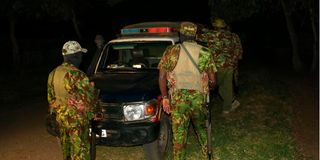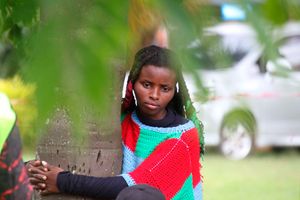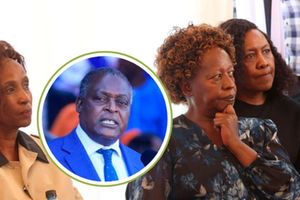Premium
Police who attacked journalists in Nakuru remain free a week later

Some of the police officers who were camped outside the gate of Kirobon Girls High School, Nakuru, on April 9, 2025.
What you need to know:
- Despite being clearly identifiable in press jackets and carrying professional gear, the journalists were attacked without warning.
- National Police Service Spokesman promised that action would be taken against any officer found to have acted improperly.
More than a week after six journalists were teargassed and assaulted by police officers in Nakuru, no officer has been held accountable despite public outrage and promises of swift investigation.
The incident occurred on the night of April 8 outside Kirobon Girls High School where journalists had gathered to cover the dramatic arrest of former Kakamega senator and UDA Secretary General Cleophas Malala.
Mr Malala, the scriptwriter of the Butere Girls High School’s play Echoes of War, had travelled from Kakamega but was barred from accessing the school.
The students were preparing to stage their play at the National Drama and Film Festival following a High Court order overturning an earlier ban. The play explores themes linked to the Gen Z-led protests against the Finance Bill 2024.
On April 3, the High Court had directed the school principal to recall the students for the performance.
Mr Malala arrived at Kirobon at around 5:30 pm to oversee final rehearsals only to find heavy security at the main gate. Police blocked his vehicle from entering the compound. Hours later several police vehicles surrounded his car preventing him from leaving.
Around 7.40pm, over 15 journalists from various media houses arrived and began conducting interviews and preparing for live broadcasts.
Under the command of Njoro Sub-County Police Commander David Apima, more than 20 officers both in uniform and plainclothes from Central, Njoro and Menengai police stations regrouped at the scene.
A plainclothes officer in a navy jacket, red T-shirt and black cap ordered the journalists to leave. Their pleas to finish the broadcast were ignored and he left vowing to “deal with them,” accusing them of obstructing a sensitive operation.
Shortly afterward, Mr Apima and the same officer returned and knocked on Malala’s car window before walking away again while the officer was talking on the phone.
Despite being clearly identifiable in press jackets and carrying professional gear, the journalists were attacked without warning as some were broadcasting live and chaos erupted.
Teargas canisters were fired directly at the journalists as they scattered for safety drawing alarm from nearby residents. Amid the confusion, police arrested Malala as six journalists were injured during the fracas.
Royal Media cameramen Evans Asiba and Robert Maina were assaulted by officers in anti-riot gear. Mary Anne Nyambura was injured after a teargas canister hit her. Standard Group’s Carolyne Chebet and KTN’s Peter Kimani and Kennedy Gachuhi were also roughed up.
“They saw the cameras. They knew who we were. They targeted us deliberately. We weren’t obstructing anything and we were just doing our job,” said Ms Nyambura who is still dealing with trauma from the incident.
National Police Service Spokesman Nyaga Muchiri, speaking on behalf of the Inspector General Douglas Kanja, released a statement promising that action would be taken against any officer found to have acted improperly during the “unfortunate” attack on journalists.
Last week, some of the assaulted journalists presented themselves at the Independent Policing Oversight Authority (IPOA) offices at Assumption Plaza in Nakuru. However, most boycotted recording statements citing past delays in justice.
They singled out the case of Wanjeri Kariuki, a Kameme FM reporter shot during last year’s Finance Bill protests. More than seven months later, no one has been held accountable.
Only Ms Nyambura recorded her statement. Mr Robert Maina declined, saying he had “zero trust” in IPOA.
“One of the officers slapped me twice. But I didn’t record a statement because I have no faith in IPOA. We’re tired of being statistics,” said Mr Maina.
In response to the standoff, the Internal Affairs Unit (IAU) of the National Police Service stepped in, promising to take over the case and follow through with investigations.
Commissioner of Police with IAU Isaac Omare said they had been dispatched by the Inspector General from Nairobi to probe the entire incident surrounding the Butere Girls’ drama.
“We urge anyone harassed to record their statements so that action can be taken. Our goal is to work together and ensure peaceful coexistence,” said Mr Omare.
Nakuru Journalists Association chairman Joseph Openda confirmed that the IAU had managed to convince some journalists to file statements pledging accountability.
“There have been at least 11 cases of journalist harassment in Nakuru in the last eight months. We’re urging the IG to act firmly so that journalists can work in a safe environment,” said Mr Openda.
He added that the lack of progress in the Wanjeri Kariuki case had damaged journalists’ confidence in oversight agencies.
However, IPOA informed them that investigations into the case had been completed and forwarded to the Office of the Director of Public Prosecutions (ODPP) for action.
The repeated pattern of delay and inaction has revived fears over increasing police impunity and slow moving accountability systems.
Article 34 of Kenya’s Constitution guarantees freedom of the Press. Yet journalists continue to face threats, intimidation and violence especially when reporting on politically sensitive matters.
“This isn’t just about us. It’s about the next journalist who shows up to do their job. If we let this slide, we’re saying brutality has no consequences. IPOA needs to get to the bottom of this,” said Mr Kimani.
In the aftermath of the attack, the Kenya Union of Journalists, Media Council of Kenya, Crime Journalists Association of Kenya and Nakuru Journalists Association issued strong condemnations.





